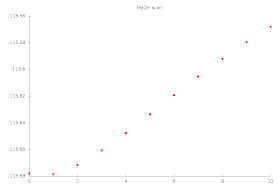Without going into discussions about the commercial behaviour of Wavefunction inc., the things I don't like about gaussian is the clunky input format (nwchem has a much more readable syntax), the inscrutable error messages, and the unreadable output. Well, it's not unreadable in a literal sense, but it could certainly be clearer. On the other hand, I've having issues with running some of my PES scans in nwchem -- and I can't find a solution (more about that in a later post)
Anyway, here's a python script for extracting optimized structures and energies from a relaxed PES scan in Gaussian 09.
First, an example of a simple scan:
And here's the script, pes_parse_g09:%nprocshared=2 %Chk=methanol.chk #P rB3LYP/6-31g 6D 10F Opt=(modredundant) NoSymm Punch=(MO) Pop=() methanol 0 1 ! charge and multiplicity C 0.0351714 0.00548884 0.0351714 H -0.617781 -0.634073 0.667983 H 0.667983 -0.634073 -0.617781 H -0.605139 0.646470 -0.605139 O 0.839603 0.818768 0.839603 H 1.38912 0.201564 1.38912 1 5 S 10 0.1
#!/usr/bin/python
import sys
def getrawdata(infile):
f=open(infile,'r')
opt=0
geo=0
struct=[]
structure=[]
energies=[]
energy=[]
for line in f:
if opt==1 and geo==1 and not ("---" in line):
structure+=[line.rstrip()]
if 'Coordinates (Angstroms)' in line:
if opt==0:
opt=1
structure=[]
if opt==1 and "--------------------------" in line:
if geo==0:
geo=1
elif geo==1:
geo=0
opt=0
if 'SCF Done' in line:
energy=filter(None,line.rstrip('\n').split(' '))
if 'Optimization completed' in line and (opt==0 and geo==0):
energies+=[float(energy[4])]
opt=0
geo=0
struct+=[structure]
structure=[]
return struct, energies
def periodictable(elementnumber):
ptable={1:'H',2:'He',\
3:'Li', 4:'Be',5:'B',6:'C',7:'N',8:'O',9:'F',10:'Ne',\
11:'Na',12:'Mg',13:'Al',14:'Si',15:'P',16:'S',17:'Cl',18:'Ar',\
19:'K',20:'Ca',\
21:'Sc',22:'Ti',23:'V',24:'Cr',25:'Mn',26:'Fe',27:'Co',28:'Ni',29:'Cu',30:'Zn',\
31:'Ga',32:'Ge',33:'As',34:'Se',35:'Br',36:'Kr',\
37:'Rb',38:'Sr',\
39:'Y',40:'Zr',41:'Nb',42:'Mo',43:'Tc',44:'Ru',45:'Rh',46:'Pd',47:'Ag',48:'Cd',\
49:'In',50:'Sn',51:'Sb',52:'Te',53:'I',54:'Xe',\
55:'Cs',56:'Ba',\
57:'La',58:'Ce',59:'Pr',60:'Nd',61:'Pm',62:'Sm',63:'Eu',64:'Gd',65:'Tb',66:'Dy',67:'Ho',68:'Er',69:'Tm',70:'Yb',71:'Lu',\
72:'Hf', 73:'Ta', 74:'W',75:'Re', 76:'Os', 77:'Ir',78:'Pt', 79:'Au', 80:'Hg',\
81:'Tl', 82:'Pb', 83:'Bi',84:'Po',85:'At',86:'Rn',\
87:'Fr',88:'Ra',\
89:'Ac',90:'Th',91:'Pa',92:'U',93:'Np',94:'Pu',95:'Am',96:'Cm',97:'Bk',98:'Cf',99:'Es',100:'Fm',101:'Md',102:'No',\
103:'Lr',104:'Rf',105:'Db',106:'Sg',107:'Bh',108:'Hs',109:'Mt',110:'Ds',111:'Rg',112:'Cn',\
113:'Uut',114:'Fl',115:'Uup',116:'Lv',117:'Uus',118:'Uuo'}
element=ptable[elementnumber]
return element
def genxyzstring(coords,elementnumber):
x_str='%10.5f'% coords[0]
y_str='%10.5f'% coords[1]
z_str='%10.5f'% coords[2]
element=periodictable(int(elementnumber))
xyz_string=element+(3-len(element))*' '+10*' '+\
(8-len(x_str))*' '+x_str+10*' '+(8-len(y_str))*' '+y_str+10*' '+(8-len(z_str))*' '+z_str+'\n'
return xyz_string
def getstructures(rawdata):
n=0
for structure in rawdata:
n=n+1
num="%03d" % (n,)
g=open('structure_'+num+'.xyz','w')
itson=False
cartesian=[]
for item in structure:
coords=filter(None,item.split(' '))
coordinates=[float(coords[3]),float(coords[4]),float(coords[5])]
element=coords[1]
cartesian+=[genxyzstring(coordinates,element)]
g.write(str(len(cartesian))+'\n')
g.write('Structure '+str(n)+'\n')
for line in cartesian:
g.write(line)
g.close()
cartesian=[]
return 0
if __name__ == "__main__":
infile=sys.argv[1]
rawdata,energies=getrawdata(infile)
structures=getstructures(rawdata)
g=open('energies.dat','w')
for n in range(0,len(energies)):
g.write(str(n)+'\t'+str(energies[n])+'\n')
g.close()
And here's what we get from the output:
g09 methanol.in |tee methanol.out pes_parse_g09 methanol.log cat structure* > meoh_traj.xyz
And here's a plot of energies.dat:



you are a god among men. thank you!
ReplyDeleteI shall direct the head of the department and the dean of the faculty to this Comment, so that my exulted status will be recognised and tenure unconditionally granted.
DeleteEither way, happy it helped!
Thanks for posting this, it's really helpful. One mistake, easily corrected: line 54 should terminate with ,\
ReplyDeleteThanks for spotting that and letting me know -- fixed now.
DeleteThanks, very useful!
ReplyDeleteVery useful, thanks a lot for sharing.
ReplyDeleteThanks lots. It's so helpful.
ReplyDeleteAs an undergrad researcher, I wholeheartedly thank you! Now I don't have to spend lonely nights sifting through .log's with vi. You are a god amongst men!
ReplyDeleteThis code and more can now be found at http://moleculargeo.chem.umu.se/codes/
ReplyDeleteMight be of help!
oh my god, thank you so much
ReplyDeleteoh my god, thank you so much
ReplyDeletenice
ReplyDeleteThank you, it is really useful.
ReplyDeleteThe 'filter' keyword does not work for me. I had to remove it and replace the phrase "filter(None,line.rstrip('\n').split(' '))" by "line.rstrip('\n').split()". Same for the coordinates also.
ReplyDelete